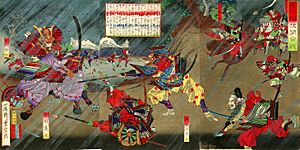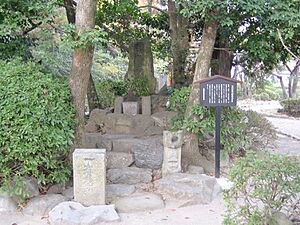Battle of Okehazama facts for kids
Quick facts for kids Battle of Okehazama |
|||||||||
|---|---|---|---|---|---|---|---|---|---|
| Part of the Sengoku period | |||||||||
 Ukiyo-e of the Battle of Okehazama by Utagawa Toyonobu [jp] |
|||||||||
|
|||||||||
| Belligerents | |||||||||
| Imagawa clan Matsudaira clan |
Oda clan | ||||||||
| Commanders and leaders | |||||||||
|
|
||||||||
| Strength | |||||||||
| 25,000 | 2,000–3,000 | ||||||||
The Battle of Okehazama (pronounced Oh-keh-hah-zah-mah) was a famous battle in Japan. It happened on June 12, 1560, in a place called Owari Province. This area is now known as Aichi Prefecture. In this battle, a smaller army led by Oda Nobunaga won a big victory. They defeated a much larger force led by Imagawa Yoshimoto. This win helped Nobunaga become one of the most important leaders during Japan's Sengoku period.
Contents
Why Did the Battle Happen?
In 1560, a powerful leader named Imagawa Yoshimoto controlled three provinces. He gathered a huge army of 25,000 soldiers. His goal was to march to Kyoto, Japan's capital. He wanted to challenge the weak government there and take control of the country.
Yoshimoto's army marched along a main road called the Tōkaidō highway. They entered Owari Province, which was ruled by Oda Nobunaga. Nobunaga had recently brought all of Owari Province under his control.
How Did the Battle Start?
Imagawa's 25,000 soldiers quickly captured Nobunaga's border forts. Forces led by Matsudaira Motoyasu (who would later become Tokugawa Ieyasu) took Marune fortress. Yoshimoto then set up his camp at Dengakuhazama. This spot was in a village called Okehazama, near what is now the city of Nagoya.
Oda Nobunaga had only about 2,000 to 3,000 soldiers. This was about one-tenth the size of Imagawa's army. Some of Nobunaga's advisors told him to retreat to his castle, Kiyosu Castle. But Nobunaga knew his castle might not survive a long attack.
Instead, he decided to fight back. He believed that a strong attack was the only way to win against so many enemies. Nobunaga and his scouts knew the area where Imagawa camped very well. They had often used it for war games and hunting.
The night before the battle, Nobunaga gathered his men. He told them it would be best to attack the enemy directly. Then he sent them home to rest. The next morning, he woke up early and got dressed. He quickly ate some rice porridge and put on his armor. He then left to lead his men.
The Battle of Okehazama
Nobunaga led his soldiers from Kiyosu Castle. They marched past Atsuta Shrine to a strong temple called Zenshō-ji. This temple was close to Okehazama, across the Tōkaidō road.
To trick Imagawa's scouts, Nobunaga ordered his men to put up many flags and banners around Zenshō-ji. This made it look like his army was much bigger than it actually was.
The exact details of the Battle of Okehazama are not fully clear. Many stories have been told about it. It is often said that Nobunaga's small army secretly moved into position. They went to an area called Kamagatani, on the other side of Imagawa's main camp. From there, Nobunaga's forces attacked Imagawa's army from the north.
However, modern historians have another idea. Because Nobunaga's army knew the land well and Nobunaga liked to attack boldly, some think it was a direct attack on Yoshimoto's camp. This might have been planned or happened by accident.
No matter how it started, Imagawa's army was completely surprised. Imagawa's soldiers were celebrating their easy victories. The afternoon was very hot, so many had taken off their armor. A sudden thunderstorm helped hide Nobunaga's movements. His troops attacked the center of Imagawa's camp, which was in a narrow valley.
The surprise attack caused a lot of panic. Imagawa's soldiers broke their lines, and many tried to run away. Imagawa Yoshimoto did not know what was happening at first. He came out of his tent, shouting at his men to stop celebrating and return to their posts. Moments later, he realized the samurai in front of him were not his own. It was too late to get his defense ready.
Yoshimoto was not killed in his main camp. He and his men quickly left their camp and joined the fighting. Yoshimoto was attacked by two Oda samurai, Mōri Shinsuke and Hattori Koheita. Yoshimoto fought bravely, even cutting through one samurai's spear. But then, Hattori Koheita tackled him and took his head.
With their leader and almost all their senior officers dead, the remaining Imagawa soldiers either gave up or ran away.
What Happened After the Battle?
The Battle of Okehazama is seen as a very important moment in Japanese history. The Imagawa clan became very weak and was soon destroyed by its neighbors. Oda Nobunaga gained a lot of respect and power. Many samurai and smaller leaders, including Imagawa's former follower, Matsudaira Motoyasu (who became Tokugawa Ieyasu), promised to support Nobunaga.
This battle was also when Nobunaga first noticed the skills of Kinoshita Tōkichirō. This man carried Nobunaga's sandals and would later become the famous leader Toyotomi Hideyoshi.
Historic Site Today

In 1937, Japan's Ministry of Education named the battlefield, Okehazama Kosenjō, a National Historic Site of Japan. It is located in Toyoake City. At the site, there are seven granite pillars called The Shichikokuhyo. Each pillar stands for one of Yoshimoto's seven warlords. The first pillar says, "Imagawa Yoshimoto was killed here."
Today, the battlefield is a peaceful park.

